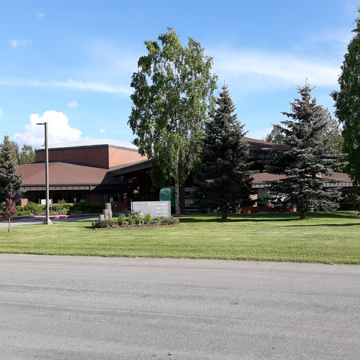You are here
Anchorage Senior Activity Center
This community center for Anchorage residents aged fifty-five years or older is owned by the Municipality of Anchorage and operated by Anchor-Age, Inc. Located in the heart of the former Eastchester Flats neighborhood on a five-acre site, the center was built as part of the area’s urban renewal. As Anchorage’s population expanded rapidly in the 1970s, city planners and leaders looked for space to house a senior facility and ultimately chose the land in the former Eastchester Flats enclave, where the city's most established Black community resided. Plans to build a senior center at this site in the mid-1970s were delayed due to neighborhood opposition to redevelopment as well as rising inflation. However, as the city grew wealthier by the late 1970s and early 1980s, opposition to the project largely faded. The growing city also presented increased demand for a senior facility.
Construction began in July 1981 for the $4.2 million (nearly $12 million in 2021), 20,000-square-foot center. The nearly completed building was gutted by fire in May 1982. The fire delayed the grand opening until the following year. The single-story brick building sits on the north bank of Chester Creek and is backed by a wooded area to the south. It is set back from the street and surrounded by parking and landscaping that incorporates plants suitable for Alaska's cold climate. A semicircular entrance drive leads to an oversized porte-cochere that forms the architectural focal point to the low-slung building, which otherwise is nestled into its wooded surroundings. Another significant architectural feature is the pyramidal skylight over the lobby, which was replaced as part of an interior renovation begun in 2021 by architect Steve Fishback. The renovation also includes system upgrades and expanded dance and weight rooms. Originally named the Anchorage Senior Center, it was renamed the Anchorage Senior Activity Center in 2005 after a 9,000-square-foot rear addition expanded the facility's classroom spaces. The Senior Center offers a variety of programs for older adults including crafts, dancing, yoga, aqua-aerobics, Pilates, tai chi, weight training, Zumba, and games.
The construction of the Anchorage Senior Center in the 1980s corresponded to a broader building boom in these same years, often referred to as Project 80s. Most of the Project 80s construction sights, however, reflected Anchorage’s ambitions to develop its cultural, civic, and athletic institutions. The senior center instead revealed a city where a critical mass of residents desired to “age in place.” This was a break from much of Anchorage’s history to that point, as it was a town mostly known for its itinerant workforce and a highly transient population. The facility remains widely used and might be viewed as a subtle sign of Anchorage maturing into a more demographically stable mid-sized city. The senior center is accredited by the National Council on Aging (NCOA).
References
Barcus, Gwen. “Seniors Ready to Try Again; Center Reopens in February.” Anchorage Daily News, October 2, 1982, F2.
Berliner, Jeff. “Blaze Destroys Senior Citizen Center.” Anchorage Daily Times, May 16, 1982, 1.
Jones, Stan. “Work Set to Begin on Fire-gutted Senior Citizens Center.” Anchorage Daily News, May 31, 1982, 1.
Schmidt, Margaret. “Special Apartment Complex to Aid Anchorage ‘Golden Agers.’” Anchorage Daily Times, February 8, 1974, 8.
Williams, Andy. “Elderly Housing Project in Limbo.” Anchorage Daily News, September 14, 1976, 2.
Wilson, Bill. “Grant-Loan Plan Would Finance Community Housing for Elderly.” Anchorage Daily Times, October 23, 1976, 42.
Writing Credits
If SAH Archipedia has been useful to you, please consider supporting it.
SAH Archipedia tells the story of the United States through its buildings, landscapes, and cities. This freely available resource empowers the public with authoritative knowledge that deepens their understanding and appreciation of the built environment. But the Society of Architectural Historians, which created SAH Archipedia with University of Virginia Press, needs your support to maintain the high-caliber research, writing, photography, cartography, editing, design, and programming that make SAH Archipedia a trusted online resource available to all who value the history of place, heritage tourism, and learning.

















